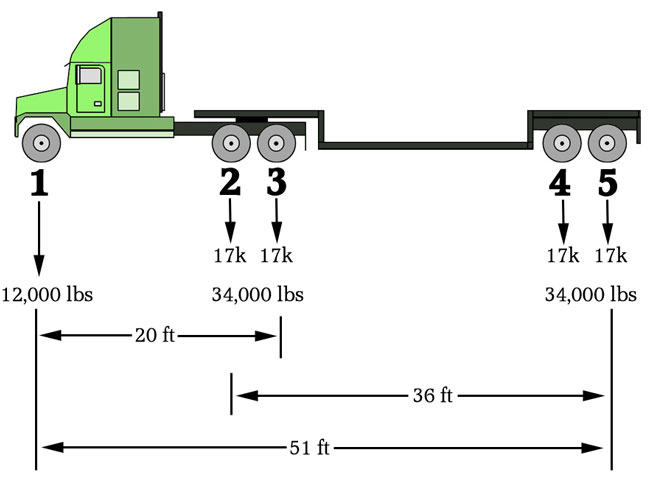Bridge Formula or Formula B
Time to get out your pencil and paper and practice that algebra we use to love in school so much. Don’t be intimated it’s not too bad, but if you are in the trucking business or certainly if you are a driver its a must to understand. This mathematical formula uses number of axles, axle spacing, and gross weight to solve for ‘w’ or the max gross weight that can be carried on any group of 2 or more axles.
- w = maximum weight that can be carried on a group of 2 or more axles.
- l = the distance between the outer axles of any axle group.
- n = number of axles in the group
The physics involved here, is that the more the gross weight is spread over a distance (axle spacing) and the more points on the ground (number of axles) the more weight you can handle. It is similar to the idea of walking on ice. If you stand up on the ice your entire weight is on your feet in a small area. This is not advised if the ice is thin! However, if you got on your hands and knees you are spreading your weight out further with more points on the ground. Even better would be to lay on the ice, but I don’t need to mention “don’t try this at home”.

Although the formula will work on any axle group and that all axle groups must comply with the bridge formula, there are 3 important axle groups that are most widely used. If these 3 are satisfied than the other axle groups general satisfy the formula B.
- Axle Group 1 – 3, an interior group called the “tractor group”
- Axle Group 2 – 5, an interior group called the “trailer group”
- Alxe Group 1 – 5, the outer group
The Bridge Formula Steps
Using the example above lets write the formula and then fill in the blanks to solve. Let’s use the “tractor group” of axles first. 1 – 3.
- w = 500(ln / (n-1) + 12n + 36)
- w = 500(20(3) / (3-1) + 12(3) + 36)
- w = 500(60 / 2 + 36 + 36)
- w = 500(30 + 36 + 36)
- w = 500(102)
- w = 51,000 lbs
Now lets try it again with the “outer group”
- w = 500(ln / (n-1) + 12n + 36)
- w = 500(51(5) / (5-1) + 12(5) + 36)
- w = 500(255 / 4 + 60 + 36)
- w = 500(63.75 + 60 + 36)
- w = 500(159.75)
- w = 79,875 lbs
The rule also states the answer is rounded to the nearest 500 lbs, so the outer group above would be 80,000 lbs. There are also charts available for quick reference that help find the answer quickly. Any transportation professional is at least familiar with this formula if he/she doesn’t always use it.
Exceptions
Yes, there always seems to be exceptions and in this case there is only one. Two consecutive sets of tandem axles may carry 34,000 lbs each if the overall distance between the first and last axle of these tandems is 36 feet or more.
We Love Heavy Haul Trucking!
 My name is Travis Smith and I've been working in the trucking business since 1994 and with Heavy Haul Trucking since 2001. Our office knows about oversize, heavy and specialty loads and how to get your load exactly where you need it, safely and on time.
My name is Travis Smith and I've been working in the trucking business since 1994 and with Heavy Haul Trucking since 2001. Our office knows about oversize, heavy and specialty loads and how to get your load exactly where you need it, safely and on time.
I enjoy writing about Heavy Haul and if you're interested in learning more, please sign up for our free newsletter. If you need a shipping quote, just call (417) 312-2920 or visit our Free Freight Quote page for more details. Google+



